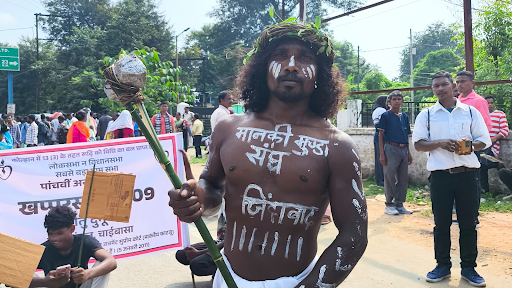
Copyright infringement not intended
Picture Courtesy: https://www.moneycontrol.com/promo/mc_interstitial_dfp.php?size=1280x540
Context:
The State Government of Assam has announced the implementation of the recommendations of the Justice Biplab Sarma Committee regarding Clause 6 of the Assam Accord.
About Assam Accord
It was an agreement signed on August 15, 1985, between the Government of India (Prime Minister Rajiv Gandhi), the Assam government, and leaders of the All Assam Students’ Union (AASU) and the All Assam Gana Sangram Parishad to end a six-year-long protest against illegal migration into Assam, especially from Bangladesh.
In Assam, protests against migrants started in 1979, with the demand that anyone who came illegally after a certain date should be identified and deported. The Assam Accord set March 24, 1971, as the cut-off date, people who came to Assam before that date would be considered Indian citizens, but those who came after would be treated as foreigners, this same date was used later while updating Assam’s National Register of Citizens (NRC).
Highlights of the Assam Accord
- The leaders of the Assam Movement agreed that migrants who came to Assam before January 1, 1966, would be accepted as Indian citizens. The government agreed to update the voter list based on this date, meaning anyone who came before 1966 would be eligible to vote.
- The government promised to identify and deport any migrants who came to Assam after March 25, 1971. Many people fled from Bangladesh (then East Pakistan) to escape the civil war in 1971. This created a lot of illegal immigration into Assam, making it a big issue for the state.
- The Indian government promised to protect the border with Bangladesh by building barriers like walls and fences, patrolling the land and rivers along the border, and building roads near the border for faster security movements.
- All charges against those involved in the Assam Movement were dropped, and the government compensate families of people who lost their lives during the protests.
- The government agreed to help Assam economically by opening an oil refinery, reopening paper mills, and establishing educational institutions.
- The accord also allowed leaders of the Assam Movement to form a political party, which later formed the state government.
About Clause 6 of the Assam Accord
Clause 6 states of the Assam Accord highlights that the “Constitutional, legislative and administrative safeguards” should be established to preserve and promote the identity of the people of Assam.
Significance of the Assam Accord
- It helped in bringing peace in Assam after years of unrest and protests. The main issue was increasing migration in Assam, especially from Bangladesh. Many local people felt that this was changing the culture, politics, and economy of Assam.
- It ensured that illegal immigrants would have to leave the state, and the government would take steps to protect Assam’s culture, language, and heritage.
- The Accord made it clear who would be considered an Indian citizen in Assam. This was crucial in ending the uncertainty around citizenship for many people living there.
- The Assam Accord is still relevant because the issue of immigration continues to be a big issue in Assam. Even today, the questions about who is a citizen and who is not are debated and discussed. The National Register of Citizens (NRC), which was updated in Assam in 2019, is a part of this ongoing issue.
|
About Justice Biplab Sarma Committee
The committee was formed in 2019 to improve the lives of Assamese people, and its suggestions are divided into three groups:
- 40 recommendations fall under the state government's control.
- 12 recommendations need approval from the Central Government.
- 15 recommendations are fully within the Central Government’s control.
Recently, the Chief Minister of Assam has announced the plans to implement 52 recommendations (those under the state and needing central approval) by April 2025. The Assam government will create a roadmap and share it with the All Assam Students' Union (AASU) by October 25, 2024.
Recommendations of the Biplab Sarma Committee
The committee suggested defining "Assamese people" to include:
- Indigenous Tribals
- Other Indigenous Communities
- Indian citizens living in Assam before January 1, 1951, and their descendants.
The state government plans to implement recommendations focusing on three main areas: land, language, and cultural heritage.
Land
- Create Special Revenue Circles where only "Assamese people" can own and transfer land.
- Launch a 3-year program to grant land titles to those who have lived on the land for a long time but don’t have proper documentation.
- Conduct special surveys of char areas (islands formed in rivers) to prioritise land allocation for those affected by erosion.
Language
- Ensure Assamese remains the official language, with provisions for local languages in certain districts.
- Make Assamese mandatory for government documents.
- All state government documents will be available in both Assamese and English.
- Establish an Autonomous Language Council to promote indigenous languages.
- Assamese to a compulsory subject in all English-medium schools up to Class VIII or even Class X.
Cultural Heritage
- Set up an authority to support the development of sattras (Vaishnavite monasteries).
- Create cultural complexes in districts to promote various ethnic groups' heritages.
Exclusions and Challenges
15 key recommendations of the committee won’t be implemented immediately. These include:
- Inner Line Permit (ILP) for Assam
- Reservation for Assamese People in Parliament and State Assembly
- Reservation in Government Jobs
- Reservation in Private Sector Collaborations
- Creation of an Upper House (Legislative Council) in Assam
|
The Sixth Schedule Areas in Assam, which include the Bodoland Territorial Council, North Cachar Hills Autonomous Council, and Karbi Anglong Autonomous Council, have the power to decide to implement these recommendations.
|
Must Read Articles:
ILLEGAL IMMIGRANT
Defining ‘Assamese’
Source:
Indian Express
THE HINDU
Wikipedia
|
PRACTICE QUESTION
Q.Discuss how the Assam Accord has influenced the cultural, linguistic, and political landscape of Assam since its signing in 1985. (150 words)
|













